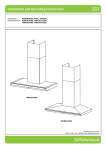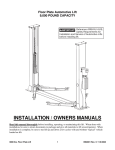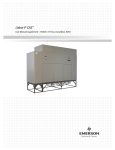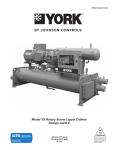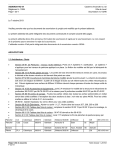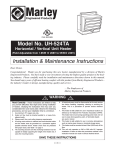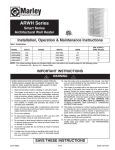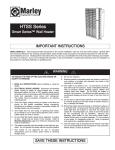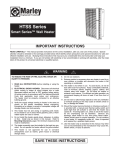Download Marley Engineered Products 7150 Technical data
Transcript
ASLC Slim Line Architectural Sill-Height Convection Heaters Dimensions Type ASLC Height Width 6” 2-3/4” 152mm 70mm Length 24” to 12’ 610mm to 3658mm Installation, Operation & Maintenance Instructions GENERAL This heater is designed to provide years of efficient, trouble free operation as a primary or supplemental heat source for comfort heating in residential and commercial applications. Installation or use of this product in any manner not described within this manual will void the warranty and could result in injury, damage to property, or permanent damage to heater. IMPORTANT INSTRUCTIONS WARNING WHEN USING ELECTRICAL APPLIANCES, BASIC PRECAUTIONS SHOULD ALWAYS BE FOLLOWED TO REDUCE THE RISK OF FIRE, ELECTRIC SHOCK, AND INJURY TO PERSONS, INCLUDING THE FOLLOWING: 1. Read all instructions before installing or using the heater. 2. A heater has hot and arcing or sparking parts inside. Do not use in areas where gasoline or flammable liquids are used or stored. 3. This heater is hot when in use. To avoid burns, do not let bare skin touch hot surfaces. Keep combustible materials, such as furniture, pillows, bedding, papers, clothes, and curtains away from heater. ! 4. To prevent a possible fire, do not block air intakes or exhaust in any manner. 5. Do not insert or allow foreign objects to enter any ventilation or exhaust opening as this may cause an electric shock or fire, or damage the heater. 6. Serious injury or death could result from electric shock. Make sure electrical power supply circuit coming to heater is disconnected at main disconnect or service panel before installing or servicing this heater. 7. ASLC model with 250 watts per linear foot or less, without wire mesh, are ETL listed for residential use. 8. ASLC model at 250 watts per linear foot must be mounted above finished floor with a clearance of 2 inches. SAVE THESE INSTRUCTIONS Clearance Chart: Table A - ASLC (Technical Data) Catalog Number 1125 1150 1188 1250 2100 2125 2150 2188 2250 3100 3125 3150 3188 3250 4100 4125 4150 4188 4250 5100 5125 5150 5188 5250 6100 6125 6150 6188 6250 7100 7125 7150 7188 7250 8100 8125 8150 8188 8250 9100 9125 9150 9188 9250 10100 10125 10150 10188 10250 Length "L" 24” (610mm) 28" (711mm) 3' (914mm) 4' (1219mm) 5' (1524mm) 6' (1829mm) 7' (2134mm) 8' (2438mm) 9' (2743mm) 10' (3048mm) Watts per ft. 125 150 188 250 100 125 150 188 250 100 125 150 188 250 100 125 150 188 250 100 125 150 188 250 100 125 150 188 250 100 125 150 188 250 100 125 150 188 250 100 125 150 188 250 100 125 150 188 250 Total Watts 250 300 376 500 200 250 300 376 500 300 375 450 564 750 400 500 600 752 1000 500 625 750 940 1250 600 750 900 1128 1500 700 875 1050 1316 1750 800 1000 1200 1504 2000 900 1125 1350 1692 2250 1000 1250 1500 1880 2500 120V --3.1 -1.7 2.1 2.5 3.1 4.2 2.5 3.1 3.8 4.7 6.3 3.3 4.2 5 6.3 8.3 4.2 5.2 6.3 7.8 10.4 5 6.3 7.5 9.4 12.5 5.8* 7.3* 8.7 10.9* 14.5* 6.7* 8.3* 10 12.5* 16.7* 7.5* 9.4* 11.2* 14.1* 18.8* 8.3* 10.4* 12.5* 15.7* -- 208V -1.4 1.8 2.4 1 1.2 1.4 1.8 2.4 1.4 1.8 2.2 2.7 3.6 1.9 2.4 2.9 3.6 4.8 2.4 3 3.6 4.5 6 2.9 3.6 4.3 5.4 7.2 3.4 4.2 5 6.3 8.4 3.8 4.8 5.8 7.2 9.6 4.3 5.4 6.5 8.1 10.8 4.8 6 7.2 9 12 Amperage 240V 277V --1.3 -1.6 1.4 2.1 1.8 0.8 -1 0.9 1.3 1.1 1.6 1.4 2.1 1.8 1.3 1.1 1.6 1.4 1.9 1.6 2.4 2 3.1 2.7 1.7 1.4 2.1 1.8 2.5 2.2 3.1 2.7 4.2 3.6 2.1 1.8 2.6 2.3 3.1 2.7 3.9 3.4 5.2 4.5 2.5 2.2 3.1 2.7 3.8 3.2 4.7 4.1 6.3 5.4 2.9 2.5 3.6 3.2 4.4 3.8 5.5 4.8 7.3 6.3 3.3 2.9 4.2 3.6 5 4.3 6.3 5.4 8.3 7.2 3.8 3.2 4.7 4.1 5.6 4.9 7.1 6.1 9.4 8.1 4.2 3.6 5.2 4.5 6.3 5.4 7.8 6.8 10.4 9 347V --------1.4 -1.1 1.3 1.6 2.2 1.2 1.4 1.7 2.2 2.9 1.4 1.8 2.2 2.7 3.6 1.7 2.2 2.6 3.3 4.3 2 2.5 3 3.8 5 2.3 2.9 3.5 4.3 5.8 2.6 3.2 3.9 4.9 6.5 2.9 3.6 4.3 5.4 7.2 For safe and efficient operation, maintain at least the following minimum clearances at all times(see Fig. 1): 600V -----------------1.3 1.7 -1 1.3 1.6 2.1 1 1.3 1.5 1.9 2.5 1.2 1.5 1.8 2.2 2.9 1.3 1.7 2 2.5 3.3 1.5 1.9 2.3 2.8 3.8 1.7 2.1 2.5 3.1 4.2 Bottom of Heater to Finished Floor: • Front Inlet Models: (max 250 watts per foot) - May be installed on floor if under 250 watts per foot. However, for best performance, install bottom of heater approximately 3 inches (76 mm) off floor. For models 250 watts per foot or more, bottom of units must be mounted at least 2” off floor. • Bottom Inlet Models: - 100-250 watts per foot – 2 inch (51 mm) Top of Heater to Ceiling (all models): - Minimum 36 inches (914 mm) Top of Heater to Bottom of Drapes (See Example 2): - Minimum 6 inches (152 mm) IMPORTANT NOTE: Certain fabrics and vinyl materials (such as vinyl blinds) may become damaged by the heated air from the heater and should not be installed above the heater. Front of Heater to Full Length Drapes (See Example 1): - Minimum between bottom of drapes and floor – 2-1/2 inches (64 mm) - Minimum between top of drapes and ceiling – 1/2 inch (13 mm) - Minimum between front of heater and nearest fold of drape – 2 inches (51 mm) Top of Heater to Bottom of Window Sill: - Minimum 12 inches (305 mm) *Available with 2 elements CEILING Example 1 Example 2 DRAPES DRAPES WALL 5 4 2 Maximum Allowable Current 4 to 5 Up to 2 3 to 4 conductors conductors conductors 4.5 Amps 5 Amps 7 Amps 6 Amps 7 Amps 9 Amps 10 Amps 12.0 Amps WALL No. 12 AWG No. 10 AWG No. 8 AWG MIN. 1/2” (13 mm) MIN. 1/2” (13 mm) Table B. Sizing Field Installed Wiring Max. No. Copper wire wire installed in wireway size 90º C CEILING MIN. 6” (152 mm) MIN. 2” (51 mm) HEATER HEATER FLOOR MIN. 2-1/2” (64 mm) Fig. 1: Clearance for Drapery 2 FLOOR Rough in Wire INSTALLATION INSTRUCTIONS 1. Run branch circuit of proper voltage and wire size to location of left or right junction box as indicated on heater wiring diagram. Basic heaters are prewired and can be connected to branch circuit at either end. Heaters with controls are prewired for connection to branch circuit at one end only (refer to heater wiring diagram). However, heater can be wired from opposite end by running wires through heater wireway. See Fig. 3 for knockout locations. TO REDUCE THE RISK OF FIRE AND ELECTRIC SHOCK OR INJURY TO PERSONS, OBSERVE THE FOLLOWING: 1. Serious injury or death could result from electric shock. Make sure electrical power supply circuit coming to heater are disconnected at main disconnect or service panel before installing this heater. 2. Wiring procedures and connections must be in accordance with the National Electrical Code (NEC) and local codes. Refer to Wiring Diagram on heater and Figure 8. Make sure all electrical connections are tight to prevent possible overheating. Use Copper Supply Wire Only. 3. Verify the electrical power supply voltage matches the voltage rating as printed on the heater nameplate. CAUTION - Never connect a heater to a voltage greater than the nameplate voltage as this will damage the heater and could cause a fire. 2. If it is necessary to run wires through the heater wireway, use Table B to size the field installed wiring. 3. The factory installed wires in the heater wireway can be loaded up to 45 amps. Refer to Table C for maximum length of heater run when the heaters are connected in parallel. 4. Do not install the heater against combustible low-density cellulose fiberboard surfaces, against or below vinyl wall coverings, or below any materials that may be damaged by heat such as vinyl or plastic blinds, curtains, etc. 5. Do not install heater below an electrical convenience receptacle (outlet). 6. CAUTION – Heater operates at high temperatures. Keep electrical cords (including telephone and computer cables), drapes, and other furnishings away from heater. For efficient and safe operation, we recommend maintaining a minimum of 6 inches (152 mm) clearance above and in front of the heater at all times. See Clearances Chart for minimum clearance requirements. 7. To reduce the risk of fire, do not store or use gasoline or other flammable vapors or liquids in the vicinity of the heater. 8. Do not install heater upside down or in any position other than as shown in this manual. 9. Do not recess heater in wall or install heater inside any type enclosure as this will cause heater to overheat and could create a hazard. 10. When mounting heater, use care when drilling mounting holes and mounting heater to building structure to avoid damaging internal heater components. Be sure to loosen mounting screws ½ turn to allow for expansion and contraction. 11. Do not remove or bypass the safety limit control(s) (thermal protectors) as this could allow heater to become a fire hazard, see heater wiring diagram supplied with heater. 12. The factory installed wires inside wireway are used to connect the built-in controls. Limit the maximum current to no more than 45 total amp. Refer to instructions and current capacity rating as provided with the accessory. 13. Heaters that are not installed end to end must have end caps installed to cover exposed ends of heater. 14. When Transformer Relay Accessory is used in this heater, all wiring within compartment where this device is installed must be rated at least 90 °C. 15. Do not allow objects to be placed on top of heater as they may be damaged or create a fire hazard. 16. To avoid damaging heater, do not use a screw driver to separate front cover from back housing. Use only a putty knife as shown, see Fig. 2 17. Before energizing, make sure front cover is properly locked onto the back housing along the entire length of the heater, see Fig. 5. Do not operate heater without front cover installed. Disconnect Switch: 20 amps @ 120-277 VAC Thermostat: 25 amps @ 120-240 VAC 22 amps @ 277 VAC Transformer Relay: 25 22 17 12 Power Relay 25 amps @ 120-277 VAC Pneumatic/Electric Switch 25 amps @ 120-277 VAC amps amps amps amps @ @ @ @ 120-240 VAC 277 VAC 347 VAC 600 VAC NOTE: For mix of watt densities, calculate amp draw. Do not exceed 45 amps. 4. Standard 90º C wiring must be used in junction boxes, wireways, blank sections, filler sections and corner sections. Room Layout Refer to heating plans for exact room arrangement of heaters (with or without thermostats and/or relays and/or switches and accessories). Check the heater section dimensions and the additional wall length required for filler sections or blank sections before starting wall-to-wall type installation. Be certain all heaters and accessories needed are at hand and are of correct finish. Mounting Height (see Clearance Chart) NOTE: Up to 3/4” thick floor covering, such as carpets, tiles, linoleum, etc., may be installed around and under the heater without adversely affecting the performance of the heaters. At correct height, draw a pencil line on the wall, level and/or parallel with the window sill. Minimum mount heights above the floor shall be as follows. Installation of Single Unit NOTE: For ease of installation, it is important that the sequence of operation indicated below be followed in order. For heaters with more than one heat deck, heat decks may be wired in parallel or each heat deck may be supplied by separate circuit. See heater nameplate for current load for each heat deck. 1. Remove unit from carton and discard external pads and plastic wrap. 2. Remove front cover by laying the heater on its back and inserting a putty knife (or other thin, wide blade tool, 1” [25mm] wide minimum) approximately 6” (152mm) from the end of the heater and prying up as shown in Fig.2. This will spring the snap lock closure open. Repeat as required down the length of the heater until the front cover completely disengages from the heater back. 3 Putty knife or other wide blade tool Cabinet front cover Recommended mounting holes drill area (for wall mounting Cabinet back housing NOTE: Illustration shown only to take off front cover. Fig. 2 3. Remove appropriate electrical knockouts from either junction box. See Fig. 3 for location of knockouts. If heater is to be pedestal mounted, consult pedestal kit installation instructions. Fig. 5 9. Following the wiring diagram secured to the heater, make electrical connections. Ground the heater using the ground screw provided. See Fig. 4. 10.Replace front cover by latching the bottom front edge of the front cover over the bottom front edge of the back and pushing the cover straight back to latch the top rear edge of the back with the top rear edge of the front cover. See Fig. 5. 4. Drill the required size mounting holes in the heater housing (See Fig. 2 for recommended mounting hole location.) 5. Hold heater housing against the wall to check for evenness of wall. Do not draw heater against an uneven wall surface. If an uneven wall is encountered, use shims to keep the heater housing straight. 1-3/8” 7/8” (35mm) (22mm) KO KO 7/8” hole 1-3/8” (35mm) KO Installation of Multiple Wall to Wall Units NOTE: For ease of installation, it is important that the sequence of operations indicated below be followed in order. 7/8” (22mm) KO 1. Repeat Steps 1 & 2 from Single Unit Installation. 2. Refer to wiring diagram for power supply entry and remove appropriate electrical knockout (Fig. 3) from the heater in which power supply connections are to be made. The power supply may be brought into the end of one heater and the remaining heaters may be connected in parallel using the wireway. Use Table B to size the field installed wiring in the wireway or use Table A to determine the maximum length or heater run possible using the factory installed wire in the heater wireway. Back Junction Box E E H W ASLC A 1.27” (32) B 2.00”(51) C 1.63” (41) D 1.37”(35) E 2.75”(70) H 2.71”(69) W 1.25”(32) X 1.00(25.4) in. (mm) X D 1-23/32” (44mm) KO A Bottom D C 3. If filler sections, inside corners, outside corners, splice kits or end caps are to be used, consult convector accessory installation instructions. If units are to be pedestal mounted, consult the convector accessories installation instructions. Pedestal placement and KOs shown are for standard units. Custom enclosures and/or heat decks will have pedestal placement and KOs in various locations. Consult factory. NOTE: If a heater has a disconnect switch and/or thermostat and is to have a filler section at either end, the filler must not cover the access to those controls. Fig. 3 4. If the run of the heaters includes an inside corner or an outside corner, mount corner to wall (see accessory installation instructions packed with corners), then mount heater. 6. Run proper size branch circuit to the junction box through the selected knockout. 5. Drill the required size mounting holes in all the heater housings. (See Fig. 2 for recommended mounting hole location.) 7. Mount the heater on the wall using screws, bolts or anchors (by installer) to suit the wall construction. 6. Hold heater housings against wall to check for evenness of the wall. Do not draw the heaters against an uneven wall surface. If an uneven wall is encountered, use shims to keep the heater housing straight. B 8. Tighten mounting screw and back off 1/2 turn to allow for expansion and contraction of the heater. 7. Run proper size branch circuit to the junction box through the selected knockout. Junction Box 8. Mount the heaters on the wall using screws, bolts or anchors (by installer) which suit the wall construction. Alignment tabs can be inserted in adjoining back housings to assure even alignment. See Fig. 6 for details. 9. Following the wiring diagram secured to the heater, make the electrical connections. Refer to Fig. 8 to connect the other heaters in parallel. Grounding of the other heaters is accomplished by connecting a jumper wire (not supplied) between the two adjacent heaters. Ground Screw 10.Replace front covers following Step 10 under Single Unit Installation, (See Fig. 5.) Fig. 4 4 MAINTENANCE INSTRUCTIONS Alignment Tab Your heater will give your years of service and comfort with only minimal care. The user can perform periodic cleaning of the exterior cabinet, but all other interior cleaning and servicing should be done by a qualified service person. Back Housing Note: For efficient and safe operation, airflow must not be restricted in and around the heater. As air moves through the heater by convection, dust and lint may accumulate in the heater and around the heating element that needs to be cleaned periodically. It is recommended that your heater be cleaned and inspected for damage at least annually (or more often if needed). Fig. 6 Blank Sections Blank sections, if any, are installed in the same manner as the heaters. 1. Serious injury or death could result from electric shock. Make sure electrical power supply circuit(s) coming to heater is/are disconnected at main disconnect or service panel before servicing this heater. Allow heater to cool before cleaning to prevent a possible burn. OPERATION INSTRUCTIONS 1. After heater(s) are completely assembled and installed, set thermostat or operating controls for NO HEAT and energize the heater circuit (s). Verify the heater(s) are not producing heat. Note: More than one power source may enter heater. Be sure all power is disconnected to heater before cleaning or servicing. 2. Adjust thermostat or operating control to call for heat. Allow heater(s) to operate for a few minutes and verify all heaters are producing heat. 2. Use care when cleaning element fins to avoiding damaging fins. Note also that fins are sharp and may cause cuts so avoid contact. Note: during initial start up, heaters may exhibit a new smell and possibly some slight smoke from the manufacturing residues on the heating element. Allow heaters to operate for approximately 30 minutes to dissipate these residues. Ventilating the area may be desired. 1. The exterior of the heater may be cleaned with a damp cloth. However, do not use harsh cleaners, polishes, or waxes as these may damage the surface or leave a residue that will discolor. 3. To set thermostat or operating controls to maintain desired comfort level, allow heaters to operate until room ambient temperature reaches the desired level. The thermostat or operating control can then be adjusted to maintain this temperature. 2. To clean interior of heater will require the removal of the front cover. To remove the front cover, disengage the top rear snap-lock first. Use an “L” shaped tool, such as an Allen Wrench, to lift up under the webs between the back row of slots (See Fig. 7). Start at either end and lift up on the front cover until the tension in the cover pulls the cabinet apart. Continue moving along the length of the heater until the cover comes off. Note: when built-in thermostat and/or disconnect switch is/or provided, access to these controls will be through grille openings at either end of the heater. To rotate the thermostat shaft will require a small flat blade screw driver. The disconnect switch is a rocker switch that can be operated with the same screw driver or tool through the openings. 3. With front cover removed, a vacuum cleaner or compressed air can be used to clear dust and lint from inside heater and around the heating element. Fins are sharp and may cause cuts so avoid contact by hands. Use care to not damage the aluminum fins. 4. If built-in thermostat is provided, after room reaches desired comfort level, rotate thermostat shaft counterclockwise until the thermostat clicks. This should allow the thermostat to cycle the heater on and off to maintain this temperature. Rotation in the clockwise direction will allow the heater to remain ON MORE and will maintain a HIGHER room ambient. Likewise, rotation in the counterclockwise direction will result in the heater remaining ON LESS and the room ambient will be LOWER. If remote thermostat or other types of controls are provided, refer to the instructions provided with these controls for proper operation. Allen Wrench or other 90º tool IMPORTANT NOTE: These heaters are provided with a built-in safety limit (Thermal Protector– see Fig. 8) to automatically turn off the heater if it is blocked or otherwise overheats due to an abnormal condition. The heaters should not be cycling off on this safety control during normal use. If this is occurring, check heater installation to assure it has adequate clearances and the free airflow around heater is not restricted. If heater continues to cycle on this safety control, discontinue using until it can be inspected and/or repaired by a qualified electrician. Front Cover Fig. 7 4. As a matter of normal maintenance, check remainder of heater for damage or possible maintenance issues while cover is removed and make any repairs needed. 5. Replace front cover as shown in Fig. 5 making sure it is locked in position along length of heater. Restore power to heater and verify it is operating properly. 5 Typical Wiring of Multiple Heaters (without controls) Thermal Protector Thermal Protector Element Element Ground Screw To other heater Ground Screws To other heater No. 10 Wires No. 10 Wires Factory Wiring Field Wiring Power Supply to Circuit Breaker Fig. 8 LIMITED WARRANTY All products manufactured by Marley Engineered Products are warranted against defects in workmanship and materials for one year from date of installation, except heating elements which are warranted against defects in workmanship and materials for five years from date of installation. This warranty does not apply to damage from accident, misuse, or alteration; nor where the connected voltage is more than 5% above the nameplate voltage; nor to equipment improperly installed or wired or maintained in violation of the product’s installation instructions. All claims for warranty work must be accompanied by proof of the date of installation. The customer shall be responsible for all costs incurred in the removal or reinstallation of products, including labor costs, and shipping costs incurred to return products to Marley Engineered Products Service Center. Within the limitations of this warranty, inoperative units should be returned to the nearest Marley authorized service center or the Marley Engineered Products Service Center, and we will repair or replace, at our option, at no charge to you with return freight paid by Marley. It is agreed that such repair or replacement is the exclusive remedy available from Marley Engineered Products. THE ABOVE WARRANTIES ARE IN LIEU OF ALL OTHER WARRANTIES EXPRESSED OR IMPLIED, AND ALL IMPLIED WARRANTIES OF MERCHANTABILITY AND FITNESS FOR A PARTICULAR PURPOSE WHICH EXCEED THE AFORESAID EXPRESSED WARRANTIES ARE HEREBY DISCLAIMED AND EXCLUDED FROM THIS AGREEMENT. MARLEY ENGINEERED PRODUCTS SHALL NOT BE LIABLE FOR CONSEQUENTIAL DAMAGES ARISING WITH RESPECT TO THE PRODUCT, WHETHER BASED UPON NEGLIGENCE, TORT, STRICT LIABILITY, OR CONTRACT. Some states do not allow the exclusion or limitation of incidental or consequential damages, so the above exclusion or limitation may not apply to you. This warranty gives you specific legal rights, and you may also have other rights which vary from state to state. For the address of your nearest authorized service center, contact Marley Engineered Products in Bennettsville, SC, at 1-800-642-4328. Merchandise returned to the factory must be accompanied by a return authorization and service identification tag, both available from Marley Engineered Products. When requesting return authorization, include all catalog numbers shown on the products. HOW TO OBTAIN WARRANTY SERVICE AND WARRANTY PARTS PLUS GENERAL INFORMATION 1. Warranty Service or Parts 2. Purchase Replacement Parts 3. General Product Information 1-800-642-4328 1-800-654-3545 www.marleymep.com 470 Beauty Spot Rd. East Bennettsville, SC 29512 USA When obtaining service always have the following: 1. Model number of the product 2. Date of manufacture 3. Part number or description Part No. 5200-11062-000 PPD 15761 06/11






